What’s involved in being a digital mentor?
People have been asking me various version of this question in the two weeks since my last column addressed the overblown anxiety about teens and smartphones. As I noted in that piece, my own research over the past several years has indicated that kids are most successful in navigating the complicated online world when they’ve had the benefit of parental guidance. Rather than focusing on how we can limit our kids’ use of tech, or conversely, enabling them to use when- and however they’d like, we need to be digital mentors who help our kids learn not just the technical but human skills that lead to meaningful online interactions and experiences.
Yet it’s not always obvious how we can mentor our kids online. A digital divide persists, not only between those families who have connectivity and those whose kids have to rely on school or libraries to get online, but in the level of resources families can commit to their kids’ online education. It’s one thing to be a mentor parent if you’ve got cash for kid laptops and weekly tech classes; it’s more challenging if you’re trying to guide your kids through the online world at the end of a double shift, without access to a computer of your own.
Over the course of several years of research on how parents manage their kids’ use of tech, however, I have seen parents embrace mentor strategies that, in many cases, involve no directly financial cost. Even more important, not every mentor is a tech expert. Digital mentorship is a strategy that’s available to any parent. Here’s what’s involved.
1. Be a Role Model
My last story raised the question of whether today’s kids are suffering less from their own use of tech than from their parents’ online habits. I well know how incredibly hard it is to resist checking your phone when you hear that telltale ping of an email arriving, even if you’re in the middle of a conversation with your kid. (That’s yet another reason it’s smart to turn off push notifications, so it’s up to you to check email when it’s convenient, instead of getting interrupted as it arrives.)
The single most important way we can teach our kids to make thoughtful, moderate use of technology is by modelling that kind of usage ourselves. Showing our kids that we organize our tech usage around our personal and professional priorities—instead of getting caught up and keeping up—is crucial if we want them to have an empowered relationship to the digital world, instead of feeling like they have to join every social network their friends use, or respond to every text the second it appears.
Being a good role model isn’t just about making judicious use of the off switch, however. It’s also about being an engaged informed user of a range of tech tools, so that you have some experience and intuition about different kinds of online interaction. No, you don’t have to become a regular Snapchat user or World of Warcraft player, but it’s a good idea to commit to some form of social media participation (so you learn the depths and limitations of social relationships online) and to give online gaming a real shot, too (so you understand the prevailing entertainment medium of our kids’ generation). And indeed, as a group, digital mentors are modestly more likely to engage in most forms of online activity, compared with other kinds of parents.
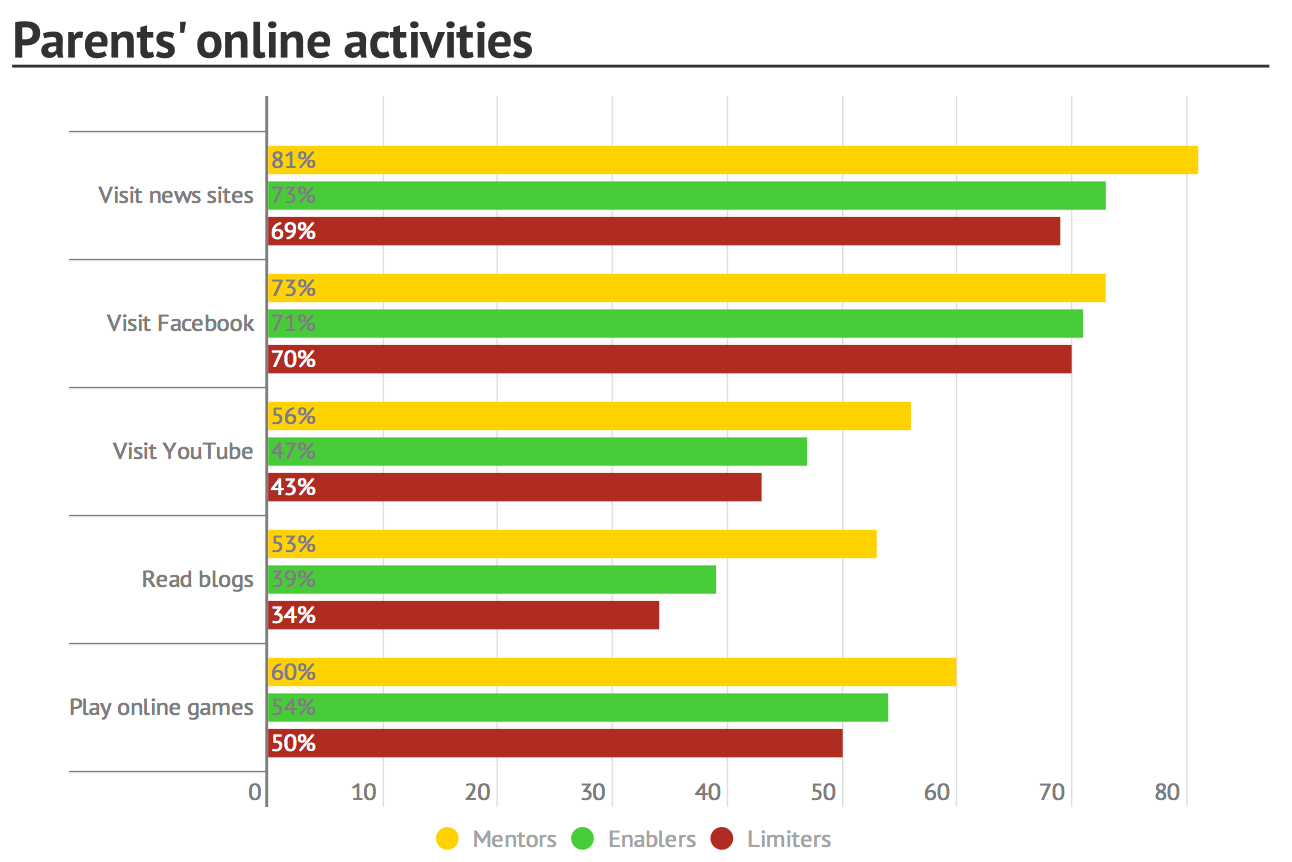
2. Foster Digital Learning
A crucial part of mentoring is actively encouraging your kids to develop the tech skills that will serve them in a digital world. That doesn’t mean you have to be a tech expert yourself: you can look for enrichment activities, or turn to techie friends who are game to nerd out with your kids. Four out of five mentor parents has enrolled their kids in computer camps, after-school programs or other tech learning opportunities, compared to only half of enabler and limiter parents; as a result, their kids are much more likely to have significant tech skills by the time they leave their teens. While there’s a lively debate over whether kids really need to program, I would argue that it’s essential for all of us to understand the fundamentals of programming logic, since programming logic now drives everything from what ads you see to which friends Facebook encourages you to engage with.
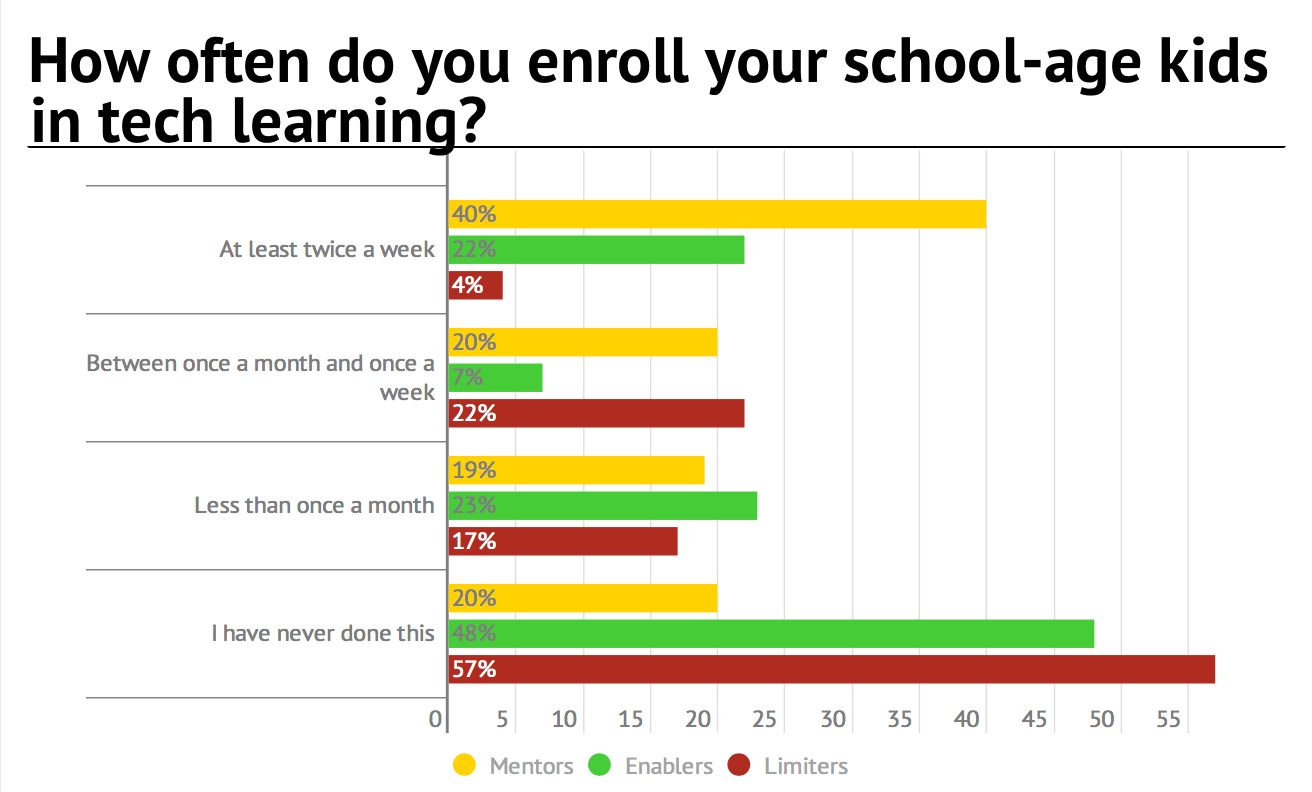
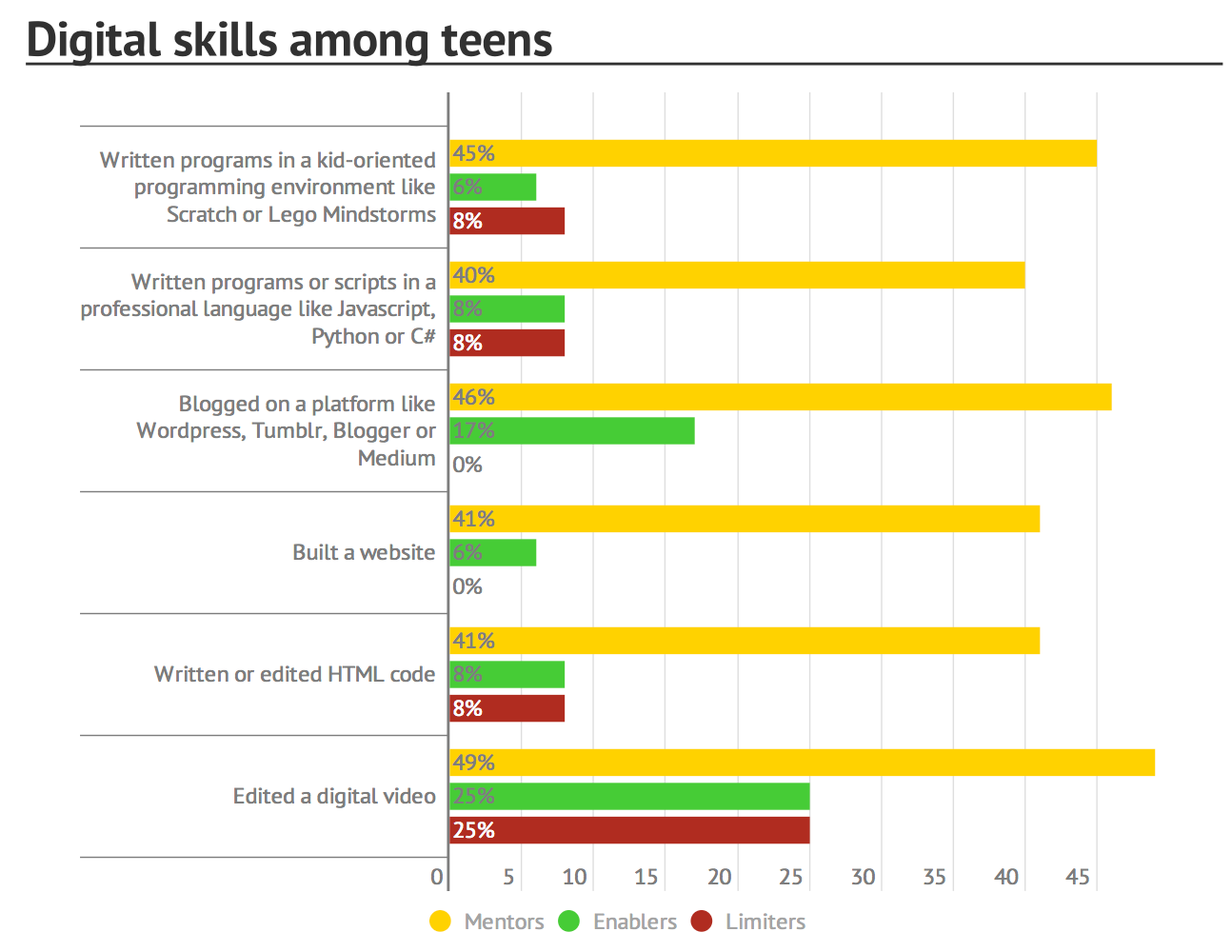
If your kid’s school doesn’t offer programming, and you can’t find an afterschool program that’s affordable or a good fit, there are tons of sites and apps that can teach your kids the rudiments of programming. Check out Scratch, Tinker, Khan Academy or Code Academy. And don’t rule out learning programming with your child, even if programming isn’t on your personal bucket list: a 2012 study that challenged kids and parents to program together found that parents’ “emphasis on analysis and design led children to write programs in a more systematic and disciplined fashion.” Even more valuable: “the parents felt that the collaboration enabled them to gain a better understanding of their children and develop a closer parent-child relationship.”
3. Manage Screen Time with Agreements, Not Bans
While mentor parents share some of the same concerns as limiter parents around excessive tech use, they address these concerns very differently. The vast majority of limiter parents ban most social networks; in part, that’s because their kids are much younger. (Half of limiter parents have preschool-aged kids, compared to just a third of mentors.) Mentor parents are less likely to ban platforms outright, which means they need other ways of shaping where and how their kids spend time online.
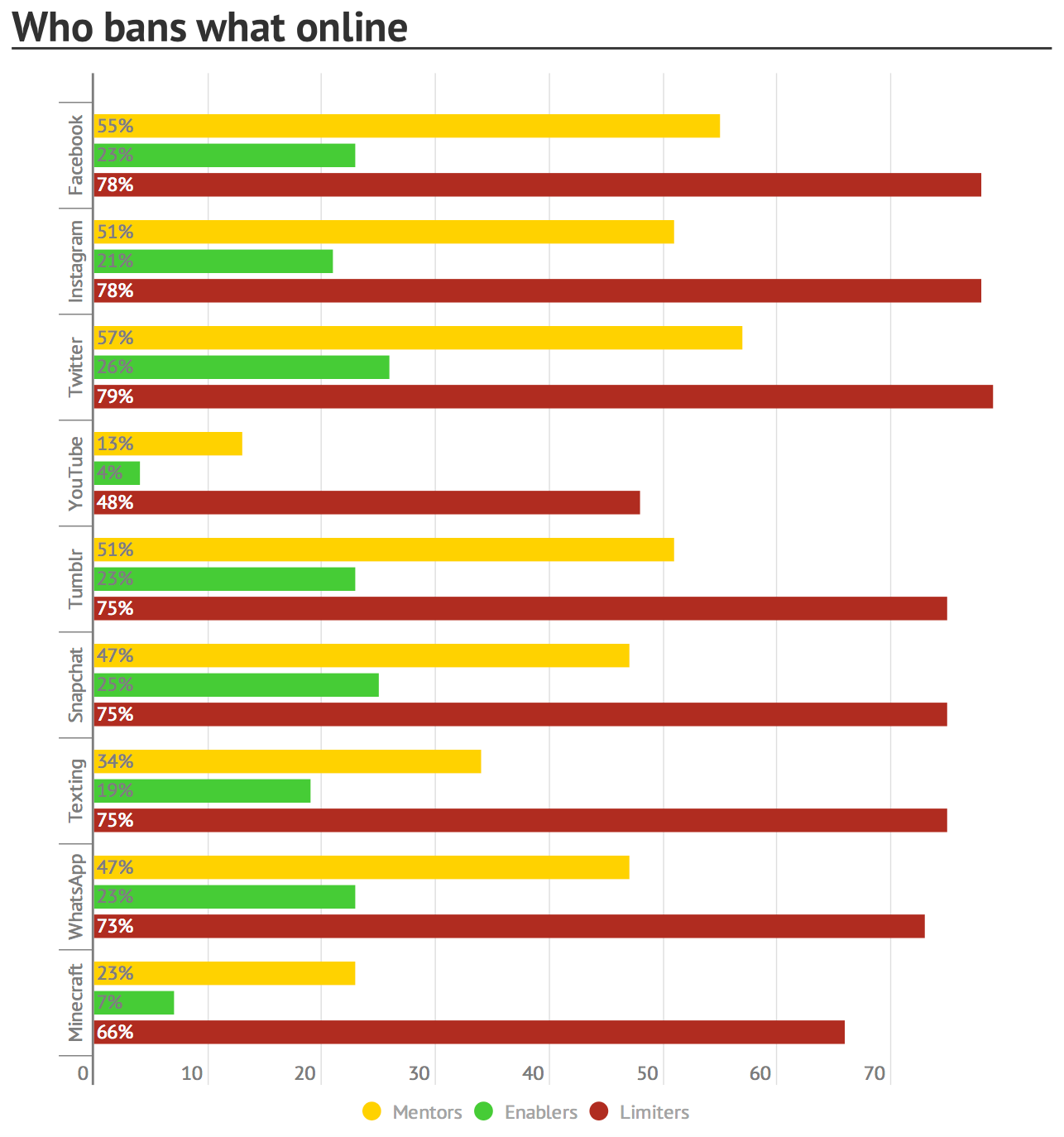
What’s the alternative? A family screen agreement. A screen agreement is something you develop with your kids, instead of imposing on them. Your screen agreement can cover things like which devices are available at what times of the day or week; which activities need to be time-limited, and which ones you’ll actively encourage; and how you’ll enforce your agreement (possibly with the help of parental controls software). This isn’t a one-time job: it’s a living document. We revise or recreate our family screen agreement every 6 to 12 months, and at various points have had specific agreements around gaming and social media.
My approach to creating screen agreements is strongly shaped by Ross Green’s collaborative problem solving (CPS) methodology, a three-step process Greene describes in books like The Explosive Child, and in his 2011 article for the Phi Delta Kappan on collaborate problem solving in school:
In the Empathy step, the adult gathers information from the student to get a clear understanding of his or her concern or perspective on an unsolved problem. Then, in the Define the Problem step, the adult introduces his or her concern or perspective about the same unsolved problem. Finally, in the Invitation step, the student and adult brainstorm realistic and mutually satisfactory solutions. By following these steps, the adults can discover durable solutions to problems, reduce the likelihood of challenging behavior, and teach important skills.
You can use the CPS approach to tackle problems like a kid who stays up late gaming, or refuses to come to the dinner table without a phone. By engaging kids in identifying the issues behind screen conflicts, we don’t just address the problem—we get a better understanding of what our kids are doing online, and why. Just as valuable, the process of developing a screen agreement gets kids thinking carefully about how they want to use technology, and how they don’t want to use it.
4. Be a Digital Detective
Mentors recognize that different kinds of screen activities have different impacts on different kids. Make sense, right? My oldest gets energized by making art on the computer, but cranky from spending too much time on Tumblr. My youngest can self-soothe by listening to an audiobook or playing a quiet narrative game, but becomes restless and anxious if he plays high-stress timed games. Thanks to the work of Stewart Shanker I’ve started evaluating my son’s gaming through the lens of self-regulation, which looks at the range of physical, mental and emotional stressors that can overload a kid’s “brain thermostat” so that their ability to self-regulate gets overwhelmed. As a result, we’ve now updated our family screen agreement to allow only those games that are regulating for my son (or at least, not dysregulating). You can find my list of low-stress games here. (Your mileage may vary.)
To understand how different to online activities affect your kids, you need to be something of a digital detective. Even if your kid disappears into the screen for hours at a time, you can still ask them what they’re doing. By tracking how your kids’ online activities relate to their mood, energy level and/or academic performance, you can get a sense of which activities unleash their creativity, and which ones leave them moody or hostile. Since most of us have very strong biases about which tech activities are more or less worthwhile, it’s helpful to keep a log of your kid’s online activities and mood for a few weeks so that you’re sure the the relationship you’re seeing is real.
That may seem like a lot of work, but if your kid’s having social, behavioural or academic trouble that you suspect are related to screen time, it’s worth the effort. There are apps that can help with both sides of this equation: parental control tools like Disney’s Circle (which is what we use in our house) can give you metrics on where your kids spend time online; apps like We Feel or MoodMeter can help you log your kid’s mood or energy levels. Ideally, you’ll engage your kid as a partner in that process: spying on your kid (especially as they get older) is unlikely to foster open communication about what they do online. My son enjoyed a project in which we measured his heart rate (again, using an iPhone app) before and after gaming sessions, and the process helped him tune into the way that gaming affected his nervous system.
5. Protect Your Kids’ Privacy
The job of protecting your kids’ online privacy doesn’t begin the day you catch them sharing racy photos on Instagram, or posting family secrets on Facebook. The job of building a family privacy culture begins when your kid is born: if you’re posting your baby’s birth announcement (with birth date!), your toddler’s cute bathtub photos, or your kindergartener’s verbal misfires, you can hardly object when they grow into a teen with no sense of online boundaries.
Starting from the time my kids were still preschoolers, we introduced the principle that we always ask one another before we post online, and while that practice has evolved and changed over the years, we see the way our kids have internalized that norm of consent by the fact that they explicitly talk to us about what we can and can’t share. (And now, about what they can and can’t share.)
Another tool many mentors use to manage their kids’ digital footprint is the use of pseudonyms, or handles. Choosing a consistent online nickname, handle or pseudonym is a way for kids to develop an online presence and set of relationships…without being vulnerable to real-world harassment or long-term consequences. Think of this digital nickname as a playground where your kid can learn about identity, explore different interests, and see the relationship between what you share and how people perceive you; and then encourage them to think about whether they want to start over with a new digital identify once they reach their late teens or adulthood.
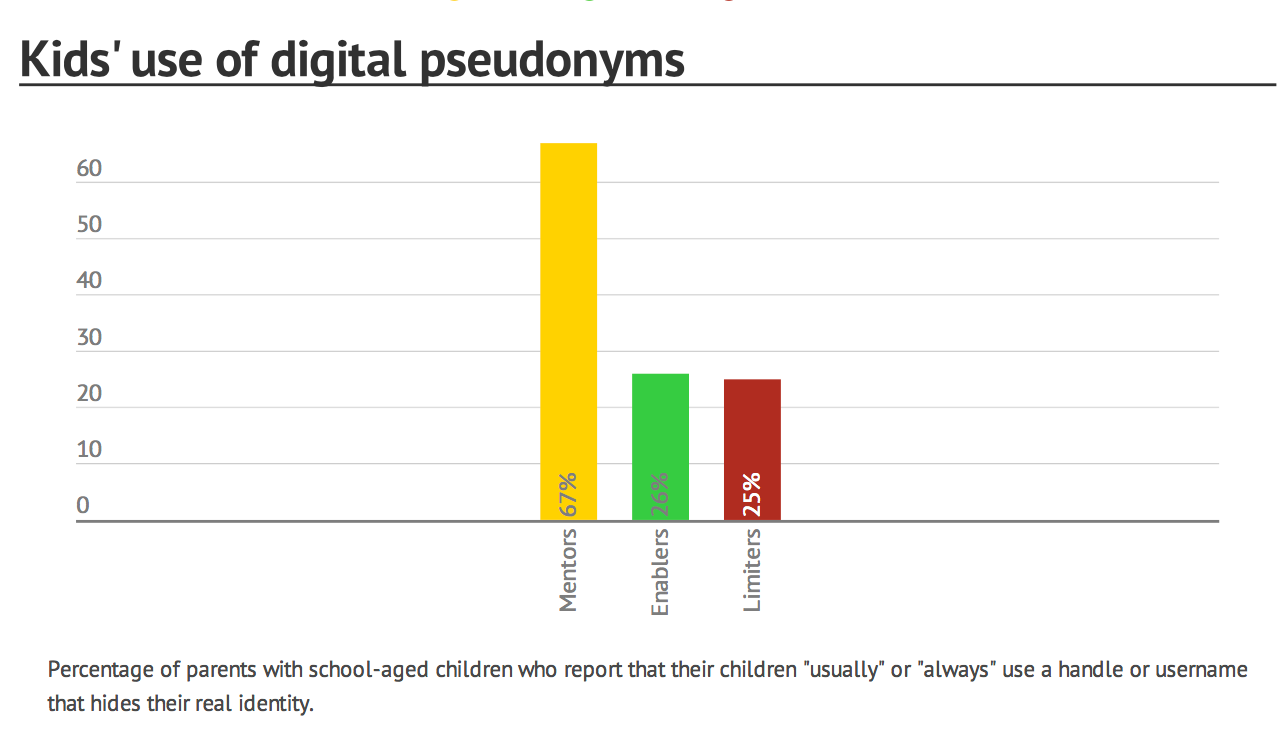
6. Talk with your Kids about Technology
Last but most important: talk with your kids about their online lives—and yours. Compared with enabler and limiter parents, mentors are much more likely to talk with their kids about what it means to use the Internet responsibly; to show their kids how to use a new program or website; to play video games with their kids; and to research devices or apps for their kids (the age- and issue-specific reviews on Common Sense Media are my favourite go-to resource). Talking with your kids is essential to their online well-being.
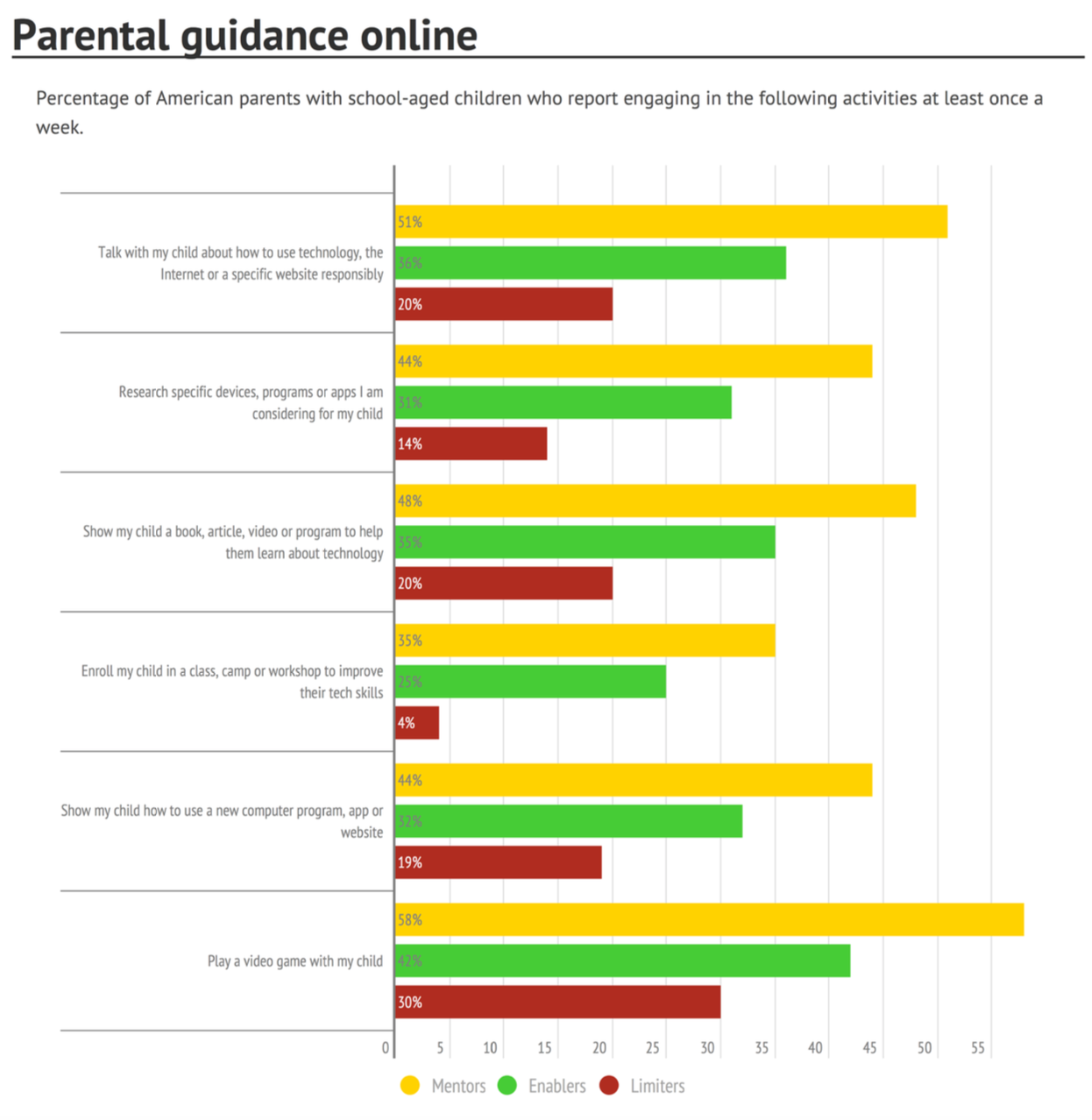
Which make sense, considering how essential it is to offline well-being. In a 2011 study of more than 5,000 Scottish young people (boys and girls aged 11, 13 and 15) based on 2006 data, researchers examined at kids’ life satisfaction (assessed by how they place themselves on a 10-rung ladder representing a scale from “the best possible life for you” to the “worst possible life”) to figure out what influences how happy kids are. In addition to looking at family structure, affluence, and health risks (like smoking, bullying, or low physical activity), they looked the role of parent-child communication by seiing how kids rated their parents and parental figures (like step-parents) in response to the question “How easy is it for you to talk to the following persons about things that really bother you?” Their results indicated that “parent-child communication is a greater predictor of life satisfaction than family structure and family affluence.”
If we know that talking with our kids is the single most important way we can support them offline, then it’s time to look at how it can help them online, too. As I argued in my last post, technology may actually harm our kids if it gets in the way of the parent-child communication that kids need to thrive. A parent who is constantly on a cell phone may not be a parent who feels “easy to talk to.”
But it doesn’t have to work that way. Technology can help us strengthen and support parent-child communication, in ways that help our kids online and off. Playing a videogame with your kid may be the way you create a relaxed space for them to open up. Exchanging emails might be an easier way for some kids to talk with their parents about a difficult issue. Or maybe Snapchat will the way your teen actually lets you know what she’s up to—or when she needs your help. As soon as you stop thinking of technology as the thing that gets in the way of conversing with your kid, you open the possibility that it can actually become a vehicle for supporting that conversation.
And of course, technology can also be part of what we and our kids talk about. You can start that conversation by asking your kid about what they’re doing online, today.
About the data
All the charts in this article are drawn from a series of surveys conducted on Springboard America and the Angus Reid Forum between March 2014 and February 2016. More than 11,000 surveys were completed by parents of children under 18; each individual survey sampled between 500 and 1000 North American parents.







